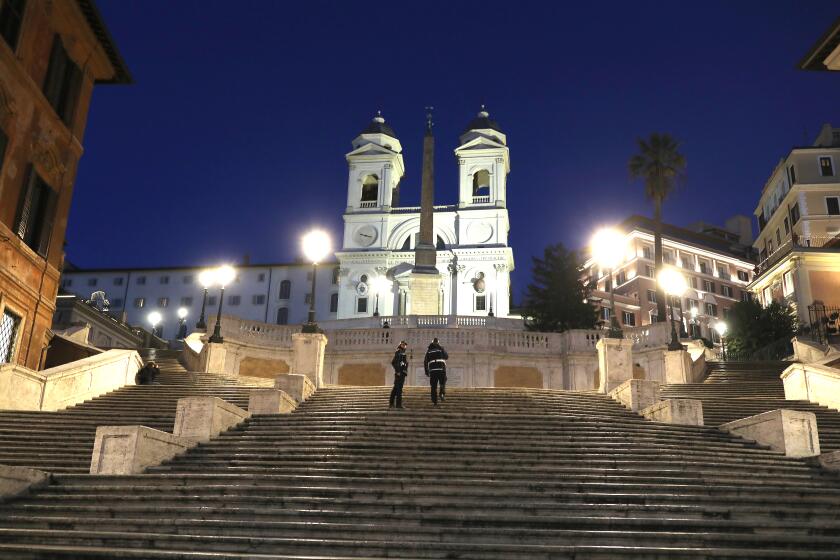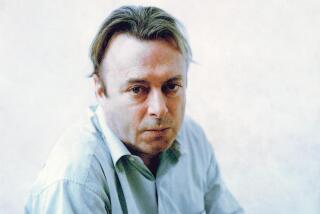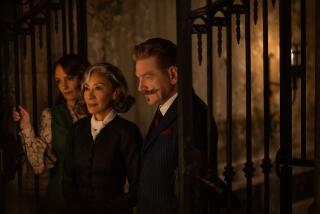Review: The demons that dogged Charles Dickens
- Share via
If you buy books linked on our site, The Times may earn a commission from Bookshop.org, whose fees support independent bookstores.
Along with Peter Ackroyd and Jan Morris, A.N. Wilson has long been one of Britain’s most productive cultural historians, never afraid to tackle subjects as big and well-covered as Tolstoy, Queen Victoria, Charles Darwin and even his home city of London. But his biggest subject yet may be Charles Dickens, a writer who contained multitudes of wildly eccentric characters, to say nothing of an entire era (the Victorian) of legal, economic and cultural inequalities.
Like other recent explorations of major literary figures, such as those by Mark Doty (on Whitman) or Martha Ackmann (on Dickinson), Wilson has taken a personal, almost memoir-ish approach to a writer who comforted the biographer at key points in his life, especially the gauntlet of British boarding school. Looking back on that difficult schoolboy period of “abject terror and hopelessness,” Wilson recalls a little help from “Nicholas Nickleby”:
“Dickens not only helped me through those moments — walled up, aged seven to thirteen, in an establishment that made the existence of the pupils at Dotheboys seem actually enviable — but also helped me in my horror-stricken recollection of those times… I survived my own childhood traumas by realizing that my tormentors were not only figures of pure horror, but also that they were as comic as Wackford Squeers, as grotesque as Fagin, though as cruel as Mr. Murdstone.”
Like Dickens’ last major biographer, Ackroyd, Wilson notes that the mere facts of Dickens’s hyper-productive life never make clear what a complicated man he truly was; and just as Ackroyd embellished his book with intermittent fictionalized passages (for which Ackroyd was often criticized), Wilson has taken a similar, near-fictive approach to Dickens’ life — posing and investigating several “mysteries” about Dickens, whose work culminated in the unfinished, often hallucinogenic “The Mystery of Edwin Drood.” The solutions to these “mysteries” may never be found, Wilson argues; but they divulge fascinating contradictions in a man whose work has entertained more generations of readers than any writer could ever dream of.
Jenn Shapland’s “My Autobiography of Carson McCullers” and Mark Doty’s “What Is the Grass,” about Walt Whitman, are hybrid memoir-biographies.
Despite his generous support of charities for unwed mothers and orphan children, Dickens created some of the ugliest caricatures of philanthropists in literature, such as the immortal Mrs. Jellyby in “Bleak House,” who devotes her attention to “the natives of Borrioboola-Gha” while her own children wander around with torn shoes and bloody, unbandaged knees. And while he promoted innate human kindness amid the cruelties of Victorian England, he eventually abandoned his wife of 22 years to a lonely house in Camden Town, forbidding his children from visiting her, just so he could set up a secret relationship with a young woman less than half his age. “It was a divided self who created the alternative comic universe that is ‘The Dickens World,’” writes Wilson. “Only a sick soul, or a divided self — however one describes it — could have created these books.”
Sick or not, he worked like he was running out of time. The most popular novelist of his age, Dickens produced millions of words of fiction, journalism and nonfiction; he directed and starred in numerous stage plays, usually for charity, and traveled the world performing popular public readings from his most famous works, “A Christmas Carol” and “Oliver Twist” — the dramatic intensity of which caused some audience members to break down weeping. (Dickens claimed his own pulse rose from 72 to 112 during a typical reading.)
Born in 1812, Dickens’ “divided” life ranged across wide extremes. His grandfather was a servant, and his father, John Dickens, was an impecunious minor civil servant ultimately sent to the notorious debtors’ prison, Marshalsea. At age 12, Dickens went to work at Warren’s Blacking Warehouse (near what is now Charing Cross Station) and suffered the endless daily hardships that he would write about through the eyes of impoverished, eternally hopeful characters — including his most autobiographical protagonist, David Copperfield. Of all the major British writers of his generation, Dickens was the only one who not only “looked over into the abyss” of the Victorian underworld, he “lived in it.”
Albert Camus’ “The Plague,” read in quarantine for the first time, warns us to reset our own priorities
Dickens’ fiction ranged across similar extremes. The early novels, such as the picaresque and serially inventive “Pickwick Papers,” were thoroughly lighthearted, featuring irrepressible protagonists who endured the worst England could throw at them — from the corrupt boarding schools of “Nickleby” to Fagin’s criminal tribe in “Oliver Twist.” Like Esther Summerson exploring the oily darkness of Chancery in “Bleak House,” early Dickens protagonists are always undaunted. Whatever dangers they encounter, they carry high a brightly burning torch of goodwill that lights them a rosy path. They endure vicissitudes. They prevail.
Yet Dickens developed a darker and more pessimistic vision of the world, even if he kept it (like his young lover in Peckham) a secret. As Wilson describes, the death of his parents released his imagination from any sense of responsibility toward them. (Not coincidentally, around the same time he abandoned his loyal wife.) As a young, eager-to-please novelist, he had transformed his impecunious father into the whimsical and charming Mr. Micawber of “Copperfield”; after his father’s death came a more selfish and unforgiving version in “Little Dorrit.” Even the lithesome and ever-hopeful David Copperfield gives way to the late-career Pip of “Great Expectations,” who discovers that his apparently serendipitous path to success has been paved by dark networks of crime, selfishness and venality.
By the time Dickens died at 58, he was “exhausted,” addicted to laudanum, his “ravaged face” resembled that of an “octogenarian”; but even as his life grew ever darker, he also produced his greatest work, including “Our Mutual Friend” and “Little Dorrit.” And while Wilson argues that Dickens’ creative career may have died a few weeks before Dickens himself, it is possible to believe (for me, anyway) that he was still capable of taking that strange and powerful final book, “Edwin Drood,” into surprising new directions. Whether the second half of “Drood” might have measured up to (or even surpassed) the first, we’ll never know. Just as we will probably never completely solve the ultimate mystery of how one smallish, imperfect man could have produced so many huge, vastly populated and perpetually absorbing novels.
11 authors, from Laila Lalami to Jonathan Lethem, on the books they might finally read in quarantine
Including Lawrence Block, E.M. Forster, Dostoyevsky and lots of “Middlemarch”
Bradfield is the author of “The History of Luminous Motion” and “Dazzle Resplendent: Adventures of a Misanthropic Dog.”
The Mystery of Charles Dickens
By A.N. Wilson
Harper Collins: 358 pages, $32.50
More to Read
Sign up for our Book Club newsletter
Get the latest news, events and more from the Los Angeles Times Book Club, and help us get L.A. reading and talking.
You may occasionally receive promotional content from the Los Angeles Times.








